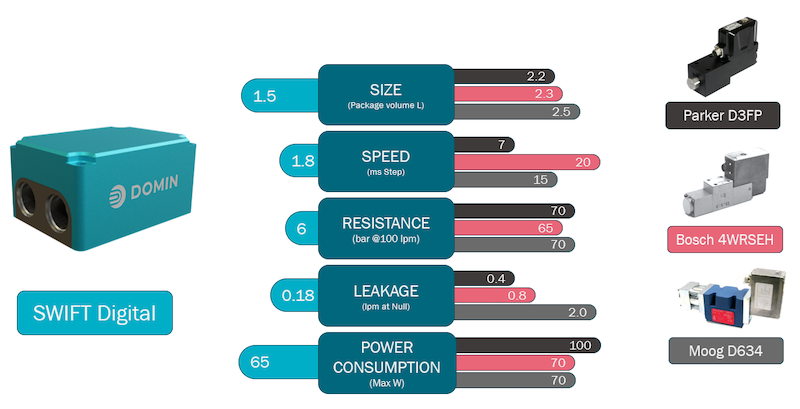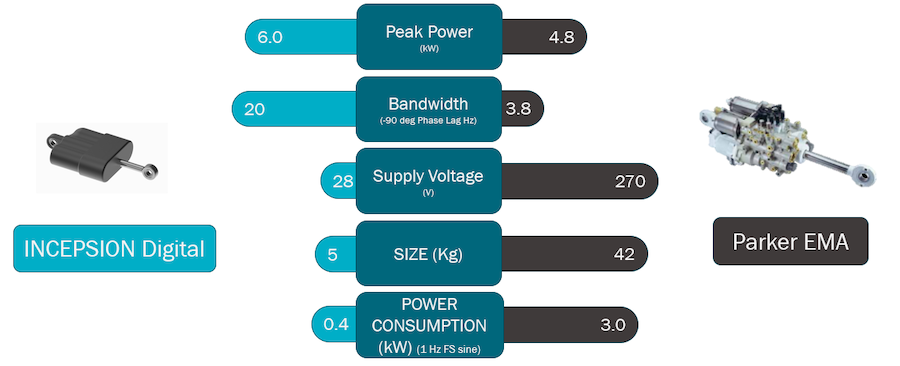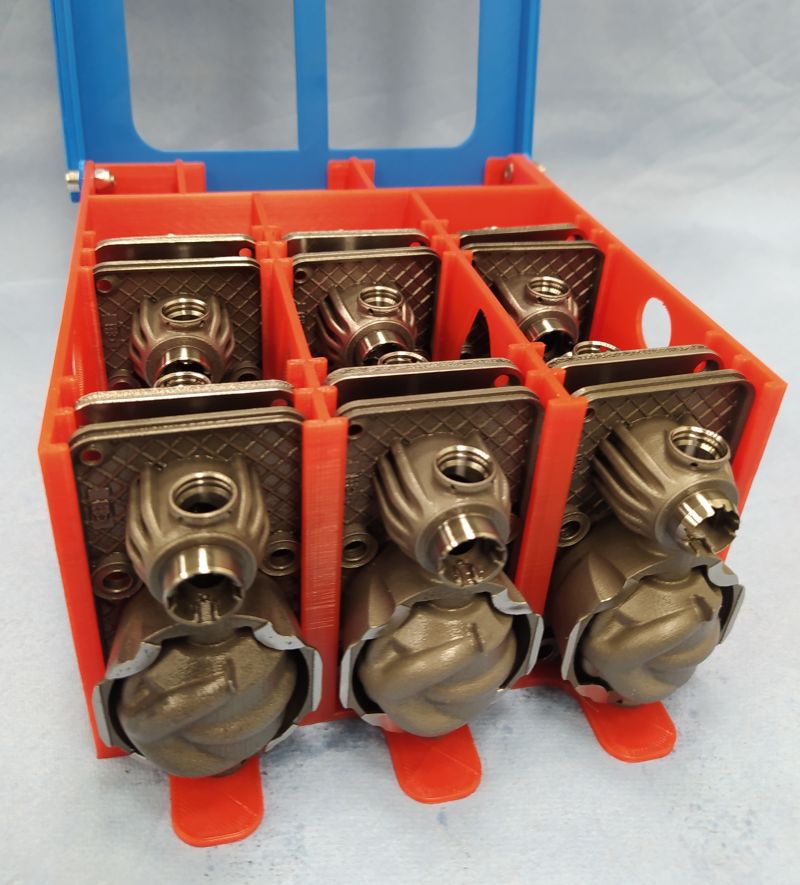Brash young UK company Domin aims to disrupt the industrial valve, hydraulics, and actuator markets through 3D printing. I love the way that the firm has tackled the challenge of 3D printing with high repeatability and quality for industrial applications, and I am enthusiastic about how transparent they are explaining their development, process and even have a webshop for their high-end direct drive hydraulic servo valves. Long dominated by Bosch, Parker Hannifin, Moog, and others, these high-end devices are used in the aviation, automotive industries and in many others besides.
The company is clear about its ambitions, stating that their products have “40% fewer parts, 24% higher flow, are 400% smaller, and 200% faster than the competition.” Less mass and weight can be of real importance as can increased performance, especially in applications where weight is key, such as car racing and aviation. 3D printing enables Domin to design and manufacture parts that are optimized for flow. But, rather than be content to sit still in the rarefied air of custom direct drives or in simply making niche products, the company wants to take the battle to the major players in major industries. With products designed in the U.K. and made in Poland, Domin wants to be a player of note.

A research project for Switch Inertance Hydraulic Systems (SIHS) that ” have typical efficiencies of 20-25%. We aim to prove technology in this project that can raise this to 80-95%,” The image shows how Domin aims to compare against the competition.
I interviewed Domin CEO Marcus Pont to find out more. Marcus is a mechanical engineer who has been working on fluid power and 3D printing since 2013. Through a series of Innovate U.K. projects, Domin ended up developing design methodologies and production expertise in fluid power products made with 3D printing. Now, its Polish facility has in-house CNC, EDM, CMM, and 3D printing for production. The firm employs 30 people in engineering and 100 in production. The Domin team is made mostly out of manufacturing and mechanical engineers.
Pont says, “We wanted to create change using additive, and revolutionize hydraulics, making it better, as well as more sustainable.” The company is now completely focused on additive, but, of course, uses a lot of conventional machined parts and processes, as well. “Metal printing for us has become a genuine production technique, but this was a difficult path,” he states. “We had to have good engineers, and take a real step back, seeing where to create change and impact on making high-performance hydraulics efficient and where will we be able to apply this technology best.”
“Our biggest problem initially was to obtain a fundamental understanding of how you approach the potential of 3D printing. The designer has to get ever closer to the manufacturing process. You have to close the feedback loop of design-to-print,” Pont said. “Making sure we have a deep understanding of design for manufacturing and that feedback loop. These elements are so deeply interconnected. One of the biggest things that we changed was to unite all of the capabilities of different designers together: design, flow engineering, stress, production engineering—all of these capabilities have to come together, or you won’t get a great product.”

Domin is working on aerospace actuators for its INCEPSION (integrated Compact Electrically Powered & Signalled Actuation Systems) which it hopes will be “5x the bandwidth of existing technologies, with half the weight and a 50% lower cost of ownership.”
Now, Domin uses maraging steel 3D printed parts, which are very high in strength. According to Pont, “They can achieve .4mm wall thicknesses while withstanding 5000 psi. With absolute strength in the fatigue of aluminum and titanium alternatives, the parts don’t end up being much lighter, but they are much more expensive. It is about design effectiveness, about the unused material, the density of the part, sustainability, strength and weight, cost and printing material where you need it.” Through design, optimization and efficient manufacturing, the company hopes to be able to tackle the regular automotive market eventually.
Marcus contrasts two sorts of high-performance valves, the two-stage valve and direct drive valves, saying, “Two-stage valves are an old technology, while direct drive is a more efficient modern technology, but these have traditionally been bigger.” By using 3D printing to shrink direct valve drives, Domin hopes to make them cost-competitive and better than conventionally manufactured ones. In turn, the company aims to see them compete “on a global scale” with the established market.

“[FDM] transport trays, printed in house, keep our direct laser melted steel valve bodies safe as they move through the factory – from machining, deburring, honing and then matching of spools & final assembly.”
Domin also hopes that the company can “fundamentally change the sustainability of hydraulics and through a 400% increase of efficiency save one billion tonnes of CO2 per year.” Custom and high-end valves were initial applications, but the firm is looking at manufacturing at scale for aerospace actuators, robotics, test systems, animatronics, energy, automotive, marine, and electric cars. It boosted in that these products all have different applications but many have the same functionality, “An airplane needs brakes; a car needs brakes. The functionality is the same.”
Pont sees part count as being a major value factor for many companies, as well as lower total cost of ownership and higher power densities in mass and volume. Lower energy cost overall is becoming a more important criterion, as well. Repair costs, especially due to contamination, should also be lower across the lifetime of their valves. He also sees his valves as being less contaminant-sensitive than the competition. Pont believes Domin’s valves are “really useful for any industry that values weight and size—not only satellites and aircraft, but there is also very little extra space on a mini forklifts and power-to-volume matters there, as well.”

A build tray of valve rotors
Pont hopes to evolve his business so that it is better than the competition “on every metric.” I really like Domin’s strong application focus and its desire to take on a demanding manufacturing application with 3D printing. This is a sector with high trust and high barrier-to-entry that drives very critical applications. It would be a bellwether for our industry if this ambitious startup made real headway in conquering the hydraulics space.
Subscribe to Our Email Newsletter
Stay up-to-date on all the latest news from the 3D printing industry and receive information and offers from third party vendors.
You May Also Like
Profiling a Construction 3D Printing Pioneer: US Army Corps of Engineers’ Megan Kreiger
The world of construction 3D printing is still so new that the true experts can probably be counted on two hands. Among them is Megan Kreiger, Portfolio Manager of Additive...
US Army Corps of Engineers Taps Lincoln Electric & Eaton for Largest 3D Printed US Civil Works Part
The Soo Locks sit on the US-Canadian border, enabling maritime travel between Lake Superior and Lake Huron, from which ships can reach the rest of the Great Lakes. Crafts carrying...
Construction 3D Printing CEO Reflects on Being Female in Construction
Natalie Wadley, CEO of ChangeMaker3D, could hear the words of her daughter sitting next to her resounding in her head. “Mum, MUM, you’ve won!” Wadley had just won the prestigious...
1Print to Commercialize 3D Printed Coastal Resilience Solutions
1Print, a company that specializes in deploying additive construction (AC) for infrastructure projects, has entered an agreement with the University of Miami (UM) to accelerate commercialization of the SEAHIVE shoreline...





























